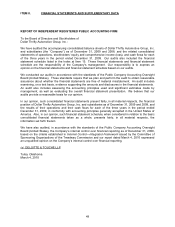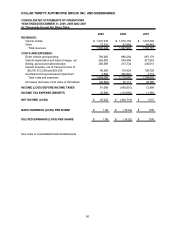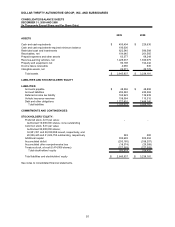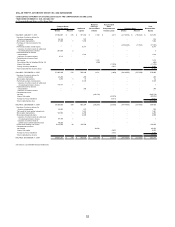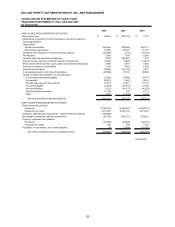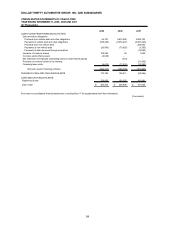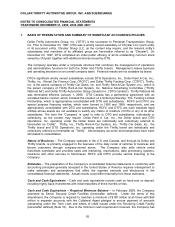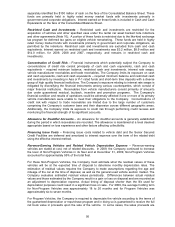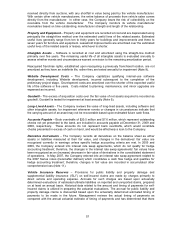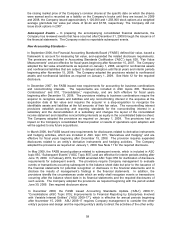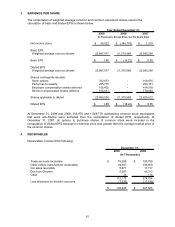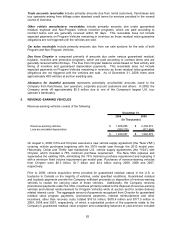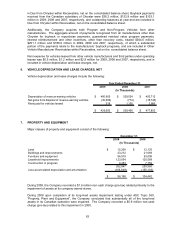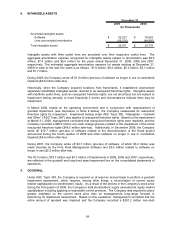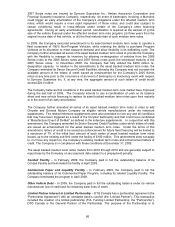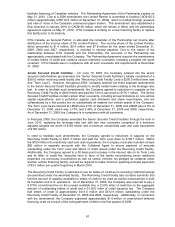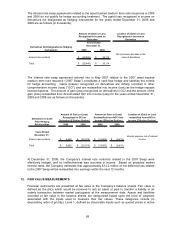Thrifty Car Rental 2009 Annual Report Download - page 60
Download and view the complete annual report
Please find page 60 of the 2009 Thrifty Car Rental annual report below. You can navigate through the pages in the report by either clicking on the pages listed below, or by using the keyword search tool below to find specific information within the annual report.the closing market price of the Company’s common shares at the specific date on which the shares
were earned and is recorded as a liability on the Company’s books until they are issued. In 2009
and 2008, the Company issued approximately 1,120,000 and 1,258,000 stock options at a weighted
average grant-date fair value per share of $4.44 and $7.58, respectively. The Company did not
issue stock options in 2007.
Subsequent Events – In preparing the accompanying consolidated financial statements, the
Company has reviewed events that have occurred after December 31, 2009 through the issuance of
the financial statements. The Company noted no reportable subsequent events.
New Accounting Standards –
In September 2006, the Financial Accounting Standards Board (“FASB”) defined fair value, issued a
framework to account for measuring fair value, and expanded the related disclosure requirements.
The provisions are included in Accounting Standards Codification (“ASC”) topic 820, “Fair Value
Measurements” and are effective for fiscal years beginning after November 15, 2007. The Company
adopted the fair value amendments as required on January 1, 2008, except for nonfinancial assets
and nonfinancial liabilities that are subject to delayed adoption until fiscal years and interim periods
beginning after November 15, 2008. The Company adopted the provisions related to nonfinancial
assets and nonfinancial liabilities as required on January 1, 2009. See Note 12 for the required
disclosure.
In December 2007, the FASB issued new requirements for accounting for business combinations
and noncontrolling interests. The requirements are included in ASC topics 805, “Business
Combinations” and 810, “Consolidation,” respectively, and are both effective for fiscal years
beginning after December 15, 2008. The provisions relating to business combinations require the
acquirer to recognize assets and liabilities and any noncontrolling interest in the acquiree at the
acquisition date at fair value and requires the acquirer in a step-acquisition to recognize the
identifiable assets and liabilities at the full amounts of their fair value. The noncontrolling interest
provisions establish accounting and reporting standards for the noncontrolling interest in a
subsidiary and the deconsolidation of a subsidiary and changes the layout of the consolidated
income statement and classifies noncontrolling interests as equity in the consolidated balance sheet.
The Company adopted the provisions as required on January 1, 2009. The provisions had no
impact on the Company’s consolidated financial position or results of operations upon adoption and
will be applied to any future acquisitions.
In March 2008, the FASB issued new requirements for disclosures related to derivative instruments
and hedging activities, which are included in ASC topic 815, “Derivatives and Hedging” and are
effective for fiscal years beginning after December 15, 2008. The provision requires expanded
disclosures related to an entity’s derivative instruments and hedging activities. The Company
adopted the provisions as required on January 1, 2009. See Note 11 for the required disclosure.
In May 2009, the FASB issued guidance related to subsequent events, which is included in ASC
topic 855, “Subsequent Events” ("ASC Topic 855”) and are effective for interim periods ending after
June 15, 2009. In February 2010, the FASB amended ASC Topic 855 for clarification of disclosure
requirements for subsequent events. The provisions require Company management to evaluate
events or transactions occurring subsequent to the balance sheet date but prior to the issuance of
the financial statements for potential recognition or disclosure in the financial statements and to
disclose the results of management’s findings in the financial statements. In addition, the
provisions identify the circumstances under which an entity shall recognize events or transactions
occurring after the balance sheet date in its financial statements and the required disclosures of
such events. The Company adopted the provisions as required beginning with the period ended
June 30, 2009. See required disclosure above.
In December 2009, the FASB issued Accounting Standards Update (“ASU”) 2009-17,
“Consolidations (ASC Topic 810): Improvements to Financial Reporting by Enterprises Involved
with Variable Interest Entities” (“ASU 2009-17”), which is effective for annual periods beginning
after November 15, 2009. ASU 2009-17 requires Company management to consider the other
entity’s purpose and design and the reporting entity’s ability to direct the activities of the other entity
59


